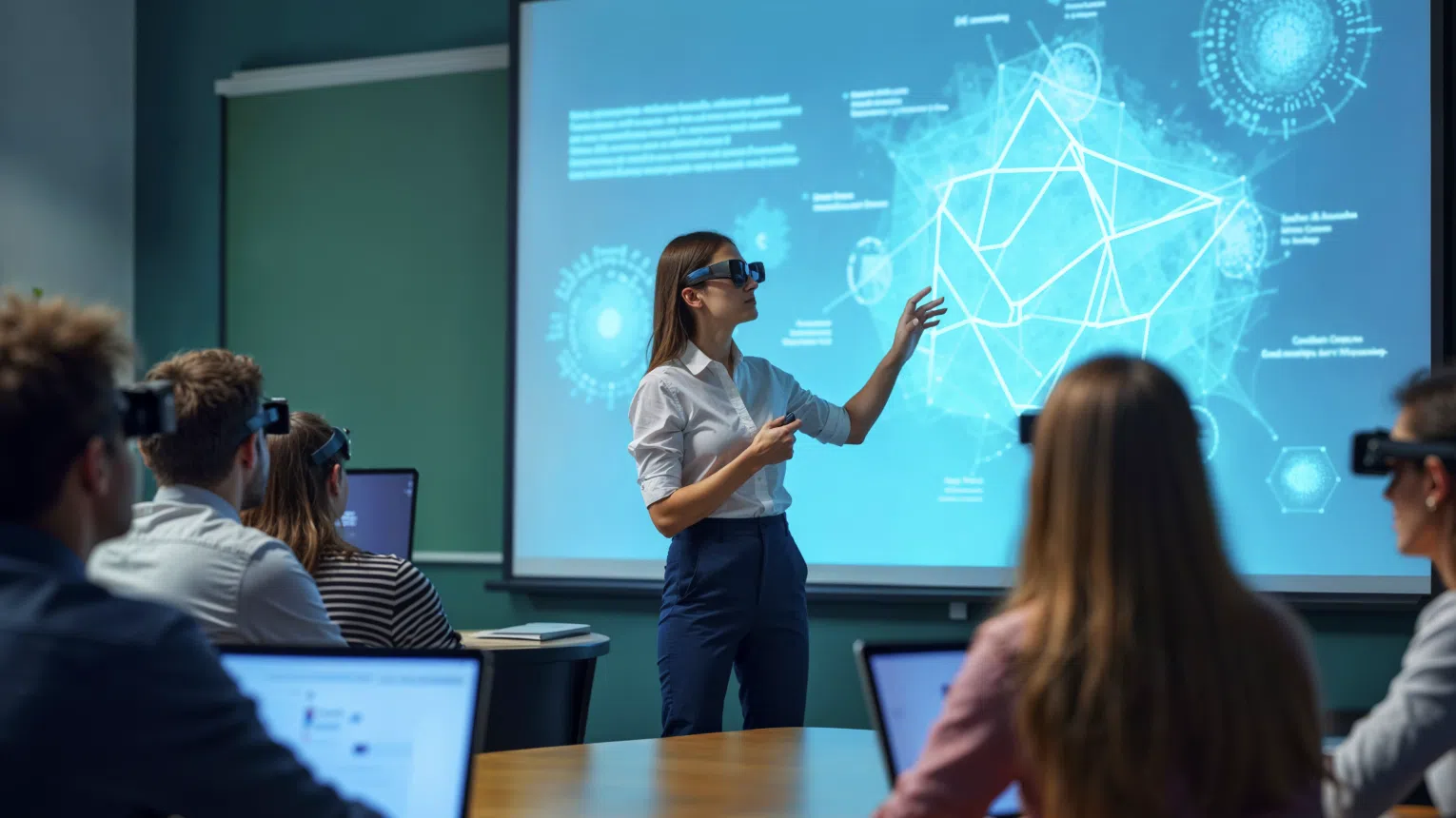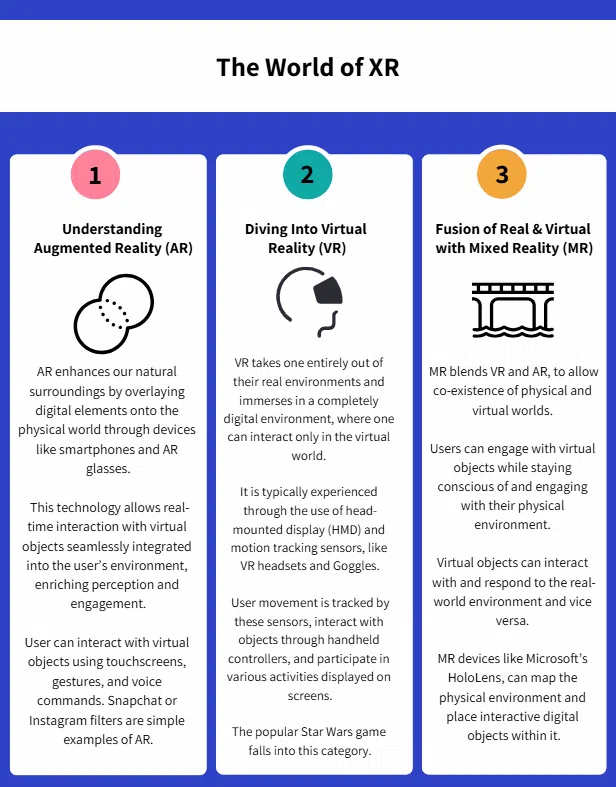XR: The X Factor of New Age Education
In this ever-evolving era of technological advancement, traditional methods of learning, and knowledge acquisition are actively taking a back seat. With internet connectivity at our fingertips and the ease of multi-device accessibility, the new age learner has transformed into a user. They demand strong stimulation of visual, auditory, and tactile senses without compromising the quality of education transfer. Extended Reality (XR) is effectively fulfilling this demand, reflected by its rapid adoption over the last decade. XR is adding more colours to the spectrum of the Educational Technology (EdTech) sector, making it even more multifaceted. Drawing on a culinary expression, XR is emerging to be the “magic method” that takes regular home cooked learning to the Michelin star level engagement and interactivity.
What is XR?
Extended reality (XR) comprises of a range of virtual and augmented experiences, that blends the physical and virtual worlds. These experiences create immersive and engaging environments where users can interact with computer-generated elements in real-time. “XR” is an umbrella term that encompasses, but is not limited to, three major technologies – Augmented Reality (AR), Virtual Reality (VR), and Mixed Reality (MR).
Tools to Implement XR in EdTech
Although there are wide range of applications and software that can be used to create XR experiences based on the applied pedagogy and desired learning outcomes, the following are some of our most used ones –
- Unity: Unity is a versatile game development engine created that allows developers to create interactive experiences across various platforms. It primarily uses C# as its scripting language, a robust and efficient platform for creating immersive and interactive experiences across various platforms, including desktop, mobile devices, Headsets, and consoles.The impact of applications created using this platform can be further enhanced by merging it with Internet of Things (IoT). Imagine you’re an engineer, walking through a factory where each machine broadcasts its status in real time – live temperature, pressure, and machine-status readings displayed above each piece of equipment as holographic overlays in your AR glasses. To take it even further, imagine that the same factory as an immersive virtual environment created in Unity, where even remote engineers can inspect live equipment. These real-time overlays eliminate the need to consult separate dashboards, instantly highlighting aberration and enabling preemptive maintenance and near-zero downtime.
- GMetri: Traditional slide‑deck training rarely excites learners, but immersive, game‑like experiences do. A perfect illustration of this is GMetri XR, a no-code browser-based metaverse toolkit to create, publish and track our own metaverse. The experiences are built by using the logic-rule-variable trilogy. GMetri allows cross-platform accessibility, and the generated experiences are quite easy to deploy.With incorporation of AI features, users can spin up fully gamified virtual worlds in minutes, deliver the same course in multiple languages with a single click, and even plug in SWOT analysis data to pinpoint skill gaps and tailor content on the fly. The result is training that feels less like “work” and more like play while still hitting every learning objective.
- Articulate Storyline: In the world of EdTech, the shift from passive content to dynamic, engaging e-learning has transformed both training and learning. Articulate’s eLearning authoring tool, Storyline, has played a key role in this evolution, allowing educators and designers to create interactive, media-rich courses. With features like customizable templates, quizzes, and simulations, Storyline reflects the broader trend of making digital learning more adaptive and immersive. Storyline’s introduction of AI features drives user engagement to the next level in less time. Easily create impactful visuals, enhance the tone and style of written content, or generate drag-and-drop activities, role-playing simulations, and adaptive quizzes catered to different learning styles. Training is more personalized and achieved in a snap!
Adding the X Factor
The benefits of applying XR technology in education and training are multifold. It’s key value lies in its ability to provide learners with hands-on experiences and simulations. It allows exploration and user interaction with complex concepts, environments, and scenarios that may not be readily available, safe, or feasible using traditional training. The following are examples of how XR truly elevates the EdTech sector.
- Risk Free Skill Development: Practicing high-stakes tasks that involve dangerous activities can be not just nerve-wracking in real life but pose real physical dangers and legal liabilities. XR offers a safe, virtual environment where people can make mistakes, learn, and perfect their skills. This not only accelerates the learning curve for professionals who perform dangerous or highly complex tasks, but reduces the risk of human error that comes with traditional training. Whether it’s rehearsing emergency scenarios or mastering technical operations, it builds confidence previously only achievable with real-life practice.Delta Air Lines implemented a VR program to train their entire workforce of de-icing technicians. This initiative allows technicians to practice de-icing procedures in realistic virtual settings, not only improving technician skills and confidence but driving significant cost savings by reducing the need for physical resources.
- Personalized Training: XR combined with IoT enables the analysis of real-time physiological data – such as head movement, eye tracking, or engagement signals from wearables and headsets – which can be used to adapt content pacing and interaction levels accordingly. For example, if a user becomes distracted during a lesson on AR welding safety, the system might pause the simulation and prompt a mini-interaction to re-engage them. Similarly, IoT sensors can monitor the learner’s attention spans and tailor future content to be shorter or longer, more interactive, or gamified. This intelligent personalization makes learning more effective, enjoyable, and aligned with individual cognitive rhythms.
- Improved Learning Outcomes: Imagine exploring the human body in 3D or simulating emergency power station drills without ever physically leaving your living room. XR has the power to literally bring concepts to life, making learning immersive and engaging. Users grasp complex concepts at a faster rate and retain knowledge longer; in ways traditional methods can’t match. By allowing trainees to “learn through action” it offers a space where they can experiment, practice, and imitate real-world situations without the stress of real-world consequences. Learners can interact with real-world objects in ways not possible in real life, such as exploring exploded views of intricate systems. Additionally, the ability of VR systems to deliver real-time evaluations and feedback further enhances this experience.According to Forbes, 75% of “World’s Most Significant Brands” tech giants including Meta, Amazon, Google, Apple, Intel, Sony, and Microsoft – are using AR or VR for precisely this reason.
- Ease of Accessibility: Applications and experiences created using XR technology are not only easily deployable across multiple device types but compatible with all popular operating systems. This means unprecedented access to advanced training technology and learning on-the-go, the perfect complement to our modern fast-paced environment.XR also offers powerful opportunities to enhance learning for those with mobility, visual, or cognitive impairments. Unlike traditional training, XR experiences can seamlessly incorporate inclusive features like voice-activated navigation, gaze-based control, haptic feedback, environment customization to control sensory needs, and audio descriptions.
- Higher Cost Savings: From virtually onboarding employees to conducting virtual training programs for global teams, companies are saving big on operational costs. Imagine a new hire touring a virtual replica of their workplace or participating in team-building exercises in a digital escape room – eliminating travel expenses, saving time, and significantly reducing staffing needs or event provider fees. Companies like Accenture, a global and highly successful professional services provider, are using VR onboarding to immerse employees in their corporate culture while fostering engagement and collaboration across global teams.XR is also extensively used by organizations to train their remote staff in soft skills and leadership development. The immersive approach enables staff to engage in role-playing exercises within a controlled, risk-free environment, fostering growth through hands-on experience. It creates measurable improvements in collaboration and performance while significantly cutting down the need for costly physical presence.As all XR training modules are reusable, both in frequency and audience, they save both time and money compared to in-person solutions.
Evolving User Psychology
New age learners are easily distracted with shorter attention spans, since they are a part of this fast-paced world, juggling many responsibilities with their plates more than full most of the times. They love mobility and flexibility at the same time like to take charge of their learning curve, constantly looking for experiences that give them ownership of the learning process, such as deciding when to finish a particular module. The fundamental characteristics of XR technologies prove to be in perfect sync with this evolving user psychology, bringing robust immersive, intuitive, engaging, transformative, and multi-sensory stimulatory educational experiences, within reach. XR is a powerful ally in creating smarter, safer, and more effective ways to learn, train, and safeguard the EdTech future.
Curious how XR can revolutionize your organization’s learning programs? Explore our immersive solutions here.



